Freesias are one of the best Spring Bulbs. The flowers come in a multitude of colours and are beautifully fragrant. Freesias grow from a corm, which is like a bulb. Once you plant them, they will grow and flower every year if they are in a position with full sun, but they will also grow in part shade. i have seen them in lawns, but you have to be careful to make sure you don't cut them off with the mower. You can also grow them in pots, and they also make great cut flowers for indoors. Freesia bulbs ( corms ) are available from Garden Centres in Autumn or early Winter. 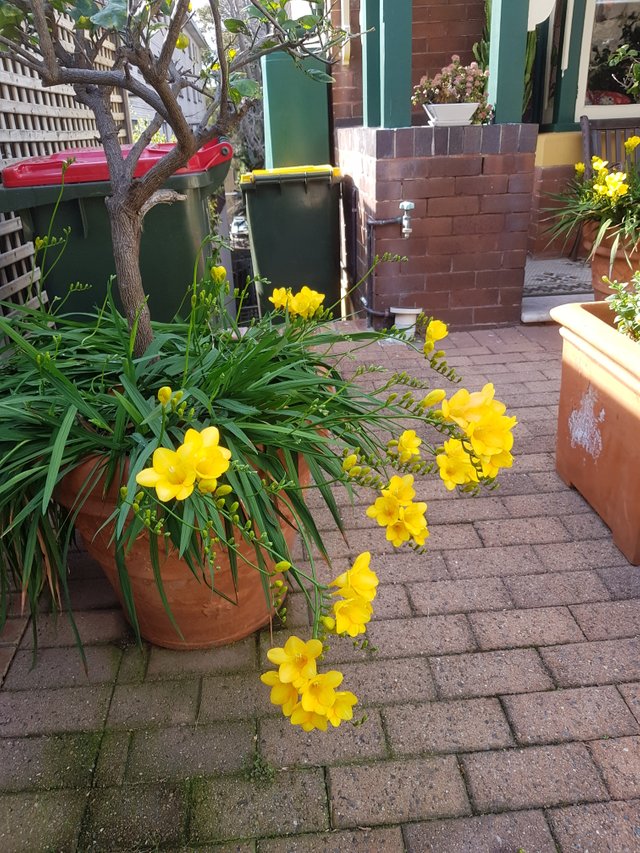
Authors get paid when people like you upvote their post.
If you enjoyed what you read here, create your account today and start earning FREE STEEM!
If you enjoyed what you read here, create your account today and start earning FREE STEEM!
Freesia Flowers are one of the most fragrant flowers. The Freesia specie, Freesia alba caused a sensation when introduced into cultivation in 1878! Along with Freesia leichteinii, this is the most deliciously, sweetest of all Freesia species.
FreesiaFreesia is a genus of about 14 species. Freesia bulbs are usually grown for use asCut Flowers. All the 14 species of Freesia are African in origin. Of The 14 Freesia species, 12 are native to Cape Province, South Africa, the remaining two to tropical Africa, with one these species extending north of the equator to Sudan.
Freesia flowers are very fragrant, typically white or yellow, and are borne in spikelike racemes. This blooming beauty captures your heart and is a springtime favorite.
Freesia plants grow from a corm (a solid bulb, as in Gladiolus). The Freesia orm sends up a tuft of long narrow leaves and a slightly branched stem. Freesia Flowers are borne as loose one-sided spikes of narrowly funnel-shaped flowers along a side few leaves.
Some excellent Freesia varieties (old-fashioned) for fragrance include: Athene, Allure, Demeter, Excelsior, Golden Wave, Mirabel, Pink Westlind, Snowdon, and Welkin. The tender, cormous plant, Freesia originated in South Africa.
Source
Downvoting a post can decrease pending rewards and make it less visible. Common reasons:
Submit
Fav. comment Award !! I really like the Pics you chose for your comment, and the good information too.
Downvoting a post can decrease pending rewards and make it less visible. Common reasons:
Submit
Freesias is an amazing flowers. It is one of the most popular cut flowers in the world. They are loved for their pure colors, long vase life and sweet perfume. Freesias can be grown at home in containers or in the garden for spring or summer flowering.
photo source
photo source
photo source
Really pleased to know about this beautiful flowers. I always know about a new flowers or plant from your every post.
Downvoting a post can decrease pending rewards and make it less visible. Common reasons:
Submit
Silly Sausage Award !! Thanks for the great choice of Pics in your comment.
Downvoting a post can decrease pending rewards and make it less visible. Common reasons:
Submit
Like bits of sunshine glinting throughout the garden, these fragrant, full freesia add a splash of cheerful yellow after the daffodils have passed. A sparkling addition for years of spring enjoyment. A snap to plant and easy to please.
The freesia genus belongs to the family Iridaceae. The genus includes 14 to 16 species of flowering plants native to Africa. Bell-shaped blooms perch atop a stem that curves, facing the blooms upward.
A popular flower for fragrance, the light pink and red varieties feature a stronger scent, according to Teleflora. Their bright colours and heavy perfume make freesia a one of the favorite cut flowers.
Freesia grows from a corm, a type of solid bulb. Long, narrow leaves surround a slightly branched stem. Six to 10 funnel-shaped flowers in single or double petal patterns grace the top of the curving stem. Stems may grow up to 18 inches in length. Blooming up to seven days, the freesia is available in a variety of colors, including yellow, white, orange, pink, red, mauve, purple, lavender and bicolored.
Resources
Downvoting a post can decrease pending rewards and make it less visible. Common reasons:
Submit
I like fragrant flowers @ctrl-alt-nwo like these Freesias will make a good garden flowering plant.
One flowering plant I like is the Fortune plant, it only flowers every few years and gives a divine smell only at night foe a few days.
Downvoting a post can decrease pending rewards and make it less visible. Common reasons:
Submit
Freesias are noted for their fragrance and bright flower colors. Native to South Africa, freesias are frost tender perennials that grow from corms. The large-flowered hybrids sold by florists feature sweetly fragrant, funnel-shaped flowers (5-10 per stem) that bloom in one-sided racemes atop leafless, arching, wiry stems to 18" tall. Many different hybrids are available in single or double blooms and in colors ranging from white, yellow, orange, red, pink, purple, lavender and various bicolors. Narrow, sword-shaped leaves appear in an iris-like fan.
http://www.missouribotanicalgarden.org/PlantFinder/PlantFinderDetails.aspx?taxonid=264594
Downvoting a post can decrease pending rewards and make it less visible. Common reasons:
Submit
Lovely freesias! I could still recall the sweet perfume of freesias during each spring in London. I had to buy at least two bunches every week for my sitting room! Several colours from purple, pink, white, yellow and orange. We can’t find these bulbs here!!
Cheers.
Downvoting a post can decrease pending rewards and make it less visible. Common reasons:
Submit
They look really beautiful and awesome charm they have wonderful to see that :D
Downvoting a post can decrease pending rewards and make it less visible. Common reasons:
Submit
Their bright colours and heavy perfume make freesia a popular cut flower. Freesias are native to South Africa where they are winter growing plants and are frost tender. The modern hybrid freesias, Freesia × kewensis, are derived from crosses between Freesia refracta and Freesia armstrongii. Prepared corms planted outside in April will flower in late summer or they can be grown in a cool greenhouse for spring flowering.
https://www.rhs.org.uk/advice/profile?PID=943
Downvoting a post can decrease pending rewards and make it less visible. Common reasons:
Submit
Freesias are tender, brightly flowered, easy to care for bulbs that can be grown in the garden,
in planters, or as a house plant in a sunny, cool room.
Their fragrant, 2" flowers open over a long blooming period, in sequence along 12"-18", arching, wirey stems.
They have narrow, sword shaped basal foliage and a few small leaves on each flower stem.
Freesias make great container plants that should be planted in the spring for garden use, or planted in the fall for growing indoors.
When growing Freesias in pots or planters, drainage is critical!
Make certain the container has sufficient drainage holes to prevent waterlogged soil, or the corms will quickly rot.
Fill the container with any good, commercial potting soil and plant the bulbs 2" deep and 2".
It is a good idea to add a support stake at planting time, to avoid root damage later.
Keep the soil shaded and barely moist until new shoots appear, then water enough to keep the soil evenly moist, but never soggy.
Feed container grown Freesias weekly when actively growing, with a good soluble fertilizer, mixed at half the recommended strength.
http://www.thegardenhelper.com/freesia.html
Downvoting a post can decrease pending rewards and make it less visible. Common reasons:
Submit
These flowers and lilies were most bought during communism on birthday or name day. And gerberas and carnations flowers for national holidays.
Looking at your photos, I have the impression that I can smell them.
Beautiful garden decoration and sense of smell :)
Greetings
Downvoting a post can decrease pending rewards and make it less visible. Common reasons:
Submit
Freesia is a genus of herbaceous perennial flowering plants in the family Iridaceae, first described as a genus in 1866 by Chr. Fr. Echlon (1886) and named after German botanist and doctor Friedrich Freese (1794-1878).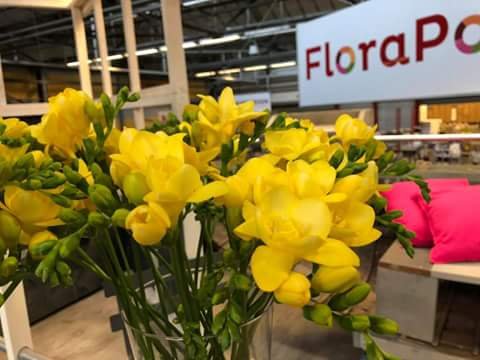
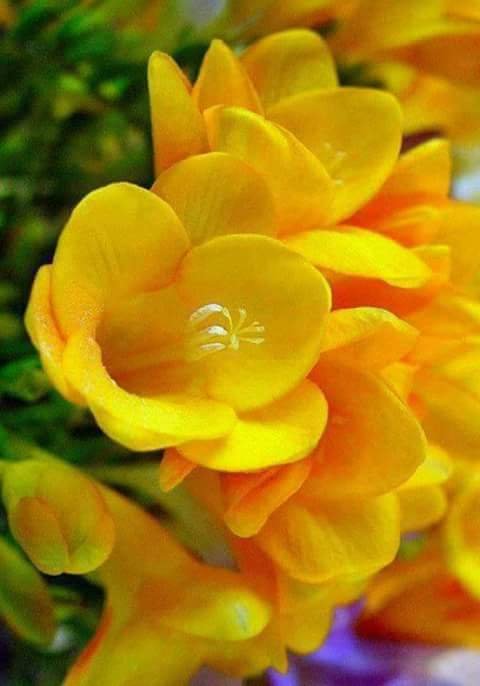
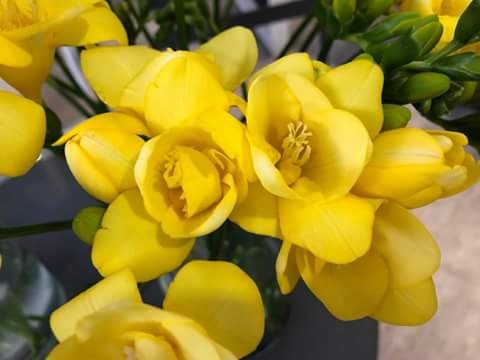
It is native to the eastern side of southern Africa, from Kenya south to South Africa, most species being found in Cape Provinces.[1] Species of the former genus Anomatheca are now included in Freesia.[1] The plants commonly known as "freesias", with fragrant funnel-shaped flowers, are cultivated hybrids of a number of Freesia species. Some other species are also grown as ornamental plants.
They are herbaceous plants which grow from a conical corm 1–2.5 cm diameter, which sends up a tuft of narrow leaves 10–30 cm long, and a sparsely branched stem 10–40 cm tall bearing a few leaves and a loose one-sided spike of flowers with six tepals. Many species have fragrant narrowly funnel-shaped flowers, although those formerly placed in the genus Anomatheca, such as F. laxa, have flat flowers. is one of the other species of the genus which is commonly cultivated. Smaller than the scented freesia cultivars, it has flat rather than cup-shaped flowers.
Extensive 'forcing' of this bulb occurs in Half Moon Bay in California where several growers chill the bulbs in proprietary methods to satisfy cold dormancy which results in formation of buds within a predicted number of weeks.
(Sourse) https://en.m.wikipedia.org › wiki › Freesia
Downvoting a post can decrease pending rewards and make it less visible. Common reasons:
Submit
Their bright colours and heavy perfume make freesia a popular cut flower. Freesias are native to South Africa where they are winter growing plants and are frost tender.
The modern hybrid freesias, Freesia × kewensis, are derived from crosses between Freesia refracta and Freesia armstrongii.
Prepared corms planted outside in April will flower in late summer or they can be grown in a cool greenhouse for spring flowering.
Source
Downvoting a post can decrease pending rewards and make it less visible. Common reasons:
Submit
@ctrl-alt-nwo,
If I didn't read what you wrote here I might think this flowers are artificial ones! It's amazing and feel like having thickness than others! Moreover the color, I like that Yellow color and truly amazing!
Great photography and a description! I have seen yellow colors but this one got more yellow than them!
Cheers~
Downvoting a post can decrease pending rewards and make it less visible. Common reasons:
Submit
How to Plant a Freesia Corm in the Garden
Knowing how and when to plant freesia bulbs is important for their success in the garden. Start by choosing a location with full sun or light morning shade and well-drained soil.
Prepare the bed by digging and loosening the soil to a depth of at least 8 inches. Plant the freesia bulbs, or corms, at least 2 inches deep and 2 to 4 inches apart.
Freesias look their best planted in groups or masses rather than in rows. Masses of a single color make a striking display. Freesias bloom 10 to 12 weeks after you plant the corms. You can extend the bloom season by planting the bulbs at weekly intervals.
Link
Downvoting a post can decrease pending rewards and make it less visible. Common reasons:
Submit
Surprisingly we have the beginning of autumn, and you have the beginning of spring, where woke up and comes to life. The beautiful season. Here's what I learned about Freesia
Freesias is one of the most popular cut flowers in the world. They are loved for their pure colors, long vase life and sweet perfume. Freesias can be grown at home in containers or in the garden for spring or summer flowering.
Each of the elegant 12 "-15" stems carries from six to twelve colors in the form of a pipe. Flowers can be monochrome or double and are available in many beautiful colors, including white, cream, yellow, orange, red, pink, lilac, lavender and purple. Freesias will fill the room with its new fragrance of baby powder.
In the cooler areas, freesias are planted outdoors in spring for late summer flowers. Bulbs can also be planted in pots in autumn and grown in a cool (55-60 ° F) greenhouse for winter flowers.
https://www.longfield-gardens.com/article/All-About-Freesia
Downvoting a post can decrease pending rewards and make it less visible. Common reasons:
Submit
A wide range of colors and an alluring floral fragrance make freesia hard to resist. With up to eight trumpet-shaped, upward-pointing blossoms on leafless stems, freesias make delightful cut flowers that last a long time in the vase. The freesia bulb plant is easy to force indoors on sunny windowsills. Learning how to grow freesias in the garden and freesia flower care will allow you to enjoy these beauties year after year.
Knowing how and when to plant freesia bulbs is important for their success in the garden. Start by choosing a location with full sun or light morning shade and well-drained soil. Prepare the bed by digging and loosening the soil to a depth of at least 8 inches. Plant the freesia bulbs, or corms, at least 2 inches deep and 2 to 4 inches apart.
Source :https://www.gardeningknowhow.com/ornamental/bulbs/freesia/planting-freesia-corms.htm
Downvoting a post can decrease pending rewards and make it less visible. Common reasons:
Submit
Certainly have a bright flower and sound easy to grow. :-)
Downvoting a post can decrease pending rewards and make it less visible. Common reasons:
Submit
freesia us very nice and beautiful flower . i really like your post

Shared on twitter.
Downvoting a post can decrease pending rewards and make it less visible. Common reasons:
Submit
Beautiful spring flowers. Spring fkowers are always beautiful and today i have learnt about a beautiful Australian flowers.
image source
image source
Flowers is always increase the beauty of our nature. And you are a beautiful man who loves flowers.
image source
I love your flowers blog. And hope next time you will share more beautiful flowers.
Downvoting a post can decrease pending rewards and make it less visible. Common reasons:
Submit
A very beautiful flower. The beautiful fragrant freesia originated from the high plateau of Cape Town in South Africa. At first they used only a few species, but because of the great interest in this culture, intensive selection work began. Today, more than 200 varieties of different colors, sizes and colors are distributed. Most of the green zones in the Netherlands and France are decorated with frescoes. Charming freesia is very capricious to light, it does not tolerate acid soil and salinity, it also requires moisture.
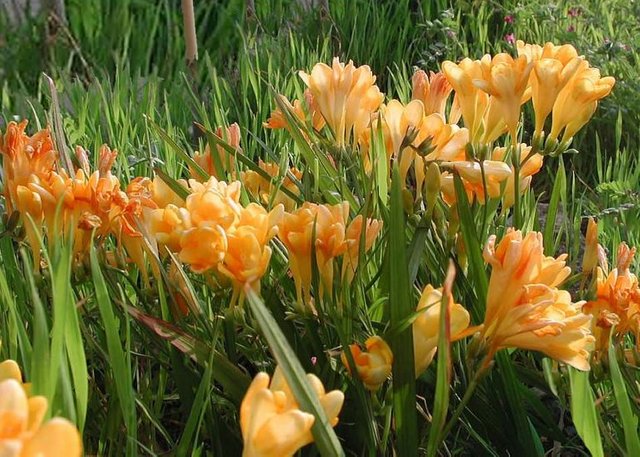
https://gradina.bg/frezia/
Downvoting a post can decrease pending rewards and make it less visible. Common reasons:
Submit
Freesia
Freesia is a genus of herbaceous perennial flowering plants in the family Iridaceae, first described as a genus in 1866 by Chr. Fr. Echlon (1886) and named after German botanist and doctor Friedrich Freese (1794-1878). It is native to the eastern side of southern Africa, from Kenya south to South Africa, most species being found in Cape Provinces.
Downvoting a post can decrease pending rewards and make it less visible. Common reasons:
Submit
It’s hard to beat freesias when it comes to pure late-summer flower power. With bold blooms in a contrasting mixture of loud colours, combined with their powerful, distinctive fragrance, they’re a true late-season delight for the senses. For this week only, you’ll save 50% on all freesias, including single- and double-flowered mixes. This half-price deal is only available while stocks last – please order early to avoid disappointment!

These gorgeous flowers bring a touch of the vibrant South African landscape right into your own garden. And, despite their exotic origin, they’re actually very easy to grow in this country. The top-quality freesia bulbs supplied by Farmer Gracy are heat treated, which means they can be planted outside in the spring and grown just like any other summer-flowering bulb.
Flowering from mid-summer to late autumn, beautifully colourful and exotically fragrant freesias provide a refreshing uplift to the garden, picking up the slack just as other summer flowers are beginning to fade. Not only do they extend the season of colour in your garden, but they’re a popular cut flower too. With exceptional vase life and a rich, powerful scent that will fill your home, there’s really so much enjoyment you can get from having your own fresh cut supply.


Freesias are very versatile and fully deserve their space in any type of planting scheme. Bright, mixed colour blooms such as these are becoming very trendy, too, with the multi-coloured ‘boho’ look now increasingly popular in urban gardens. If you have a small space, grow vivid flowers like freesias in pots positioned at different heights to create a lush, colourful surrounding. They equally good in large gardens too, providing bright pops of colour in beds and borders.
Source
Downvoting a post can decrease pending rewards and make it less visible. Common reasons:
Submit
Freesias is a wonderful spring flowers. And it also one of the most popular cut flowers in the world. I also pleased to know that we can grow it at home.
Source
Source
Source
The flowers have various colours. I appreciate your beautiful photography of Freesias flowers and thanks a lot for sharing about this beautiful flower with us.
Downvoting a post can decrease pending rewards and make it less visible. Common reasons:
Submit
A beautiful plant. Probably the smell of it is remarkable, since it is widely used in the cosmetic and perfume industry. Sometimes I see these flowers in flower shops, but, they are already cut, only for bouquets.
Downvoting a post can decrease pending rewards and make it less visible. Common reasons:
Submit
Freesia flowers are “zygomorphic” which just means that they grow along one side of the stem, in a single plane. When you look at a flower stalk however, you'll see that the blooms are facing upwards. The flowers bloom along the top side of the stalk, facing upwards. This makes them lovely to look down into in a garden setting and ideal for arrangements. If you didn't care much for geometry in high school, here's a painless way to give it another try.
Note: in zone 8 and colder, plant freesia in the spring rather than in autumn. These bulbs will not survive outside in regions colder than zone 9.
How does this work? Freesias stems have the unusual habit of turning at right angles just below the bottom flower. This causes the upper portion of the stem to grow almost parallel with the ground.
The flowers bloom along the top side of the stalk, facing upwards. This makes them lovely to look down into in a garden setting and ideal for arrangements. If you didn't care much for geometry in high school, here's a painless way to give it another try.
Note: in zone 8 and colder, plant freesia in the spring rather than in autumn. These bulbs will not survive outside in regions colder than zone 9.
Source
Downvoting a post can decrease pending rewards and make it less visible. Common reasons:
Submit
Plant Details
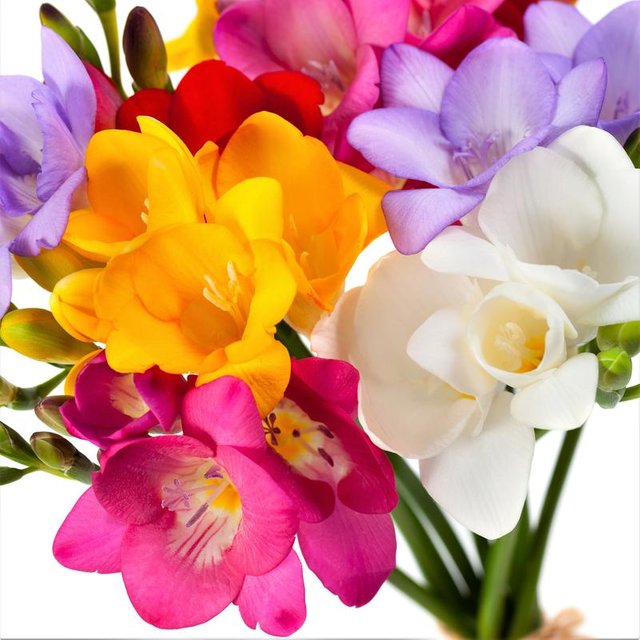
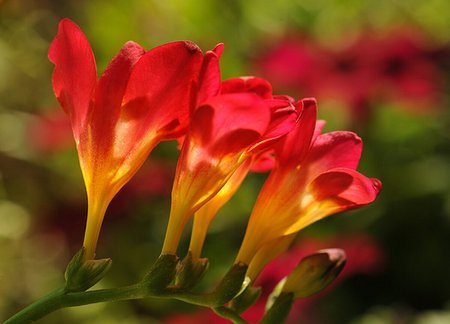
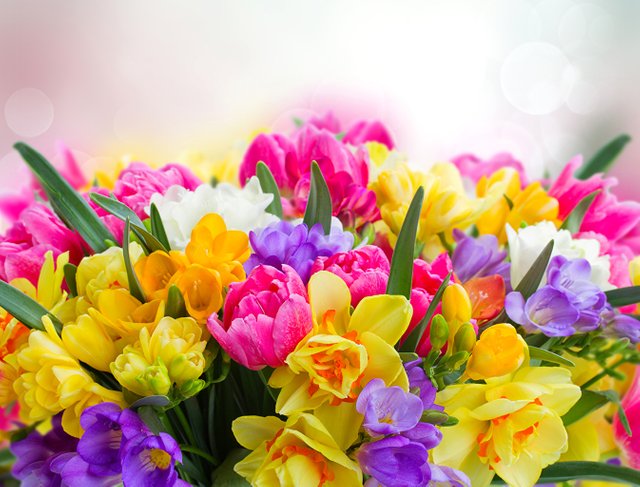
South African natives prized for the rich perfume of flowers. In spring, wiry, 1- to 1 feet stems bear spikes of tubular flowers that reach 2 inches long and flare to 2 inches wide. Each stem bends at nearly a right angle just beneath the lowest bud. Narrow, sword-shaped leaves to 1 feet tall grow in iris-like fans. Hardy to 20F.
The old-fashioned favorite Freesia lactea (F. alba) has white blooms with a powerfully sweet scent, but more commonly available today are hybrids (Dutch and Tecolote hybrids represent the majority of those sold) with single or double blossoms in yellow, orange, red, pink, lavender, purple, blue, and white. You can buy mixed-color assortments as well as named varieties in specific colors.
Plant in fall, setting corms 2 inches deep (pointed end up) and 2 inches apart in well-drained soil. Plants go dormant after bloom and need no irrigation until growth resumes in fall. In areas with high summer rainfall, it's best to dig them when foliage yellows and store the corms until it's time to replant in early fall. Freesias will self-sow if faded flowers are not removed; volunteers tend to revert to cream marked with purple and yellow. In Upper, Middle, and Lower South, plant 2 inches deep, 2 inches apart in pots and grow indoors in a sunny window. Keep room temperature as cool as possible at night. Freesias are easily grown from seed sown in July or August; they will often bloom the following spring. Flowering potted freesias grown from chilled and stored corms are available throughout the year.
https://www.southernliving.com/plants/freesia
Downvoting a post can decrease pending rewards and make it less visible. Common reasons:
Submit
Freesia is a half hardy from gladiolus family and is a lesser known flowering beauty that has not caught the fancy of many garden enthusiasts, especially in North India. Despite its exotic looks, alluring fragrance, trumpet shaped upward pointing flowers on leafless stems with a range of colours, its presence is limited only to flower shows. Those looking to add fresh appeal to their collection of flowering plants should check out this exotic-looking plant.
Pot mixture
Take equal parts of garden soil and well-rotten farm yard manure and mix them thoroughly so that no clumps remain, add a ‘neem’ cakes and bone meal to it.
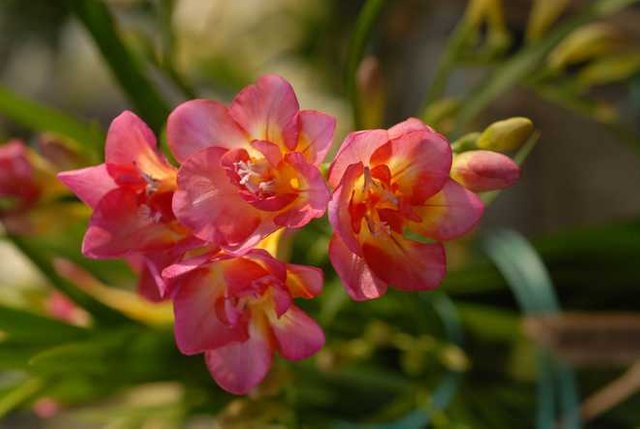
When to plant
Freesia corms are planted in mid-October. Even the small corms also produce flowers which may not be of desirable quality. The fully developed corms bloom early followed by new small corms. Flowers appear within 10-12 weeks and remain in bloom for two to three weeks depending upon the weather condition and care.
Post planting care
It is very easy to grow Freesia in this sub tropical region. All it requires is sunlight, moist well-drained soil, weeding, hoeing and regular fortnightly feeding. Periodically keep on rotating pots at regular intervals for balanced sunlight.
Once the flowering is over and bloom has died, it’s the time when Freesia is entering the inactive phase of its life cycle. Let the pot remain in sunlight for 2-3 months to store energy for next season bloom. Keep on maintaining the plant with normal routine garden operations like fertilisation, watering and hoeing etc. Wait till the green leaves turn yellow. It’s then time to prune the plant, remove dried and dead leaves. Move the plant in to a cool dry place to allow it to enter dormancy. Reduce water to just keep the soil lightly moist as good as dry.
If the plants are a few years old, consider them for multiplication. Take out the entire plant from the pot and gently separate all the corms and remove the soil and place them on a newspaper. Separate the old parent corm from the new young corms for further propagation. Withdraw the corms and air dry and wrap them in a news paper and store them in cool dark place.
Diseases
If the storage conditions are not proper, pupa formation occurs on the corm and effect the plant health. During rainy season be careful about fungal infection and treat with ‘Bavistin’.
Downvoting a post can decrease pending rewards and make it less visible. Common reasons:
Submit
Fragrant flowers in a stunning colour range. These blooms are a spring must have, the flowers are profuse, easy to grow and will flower for weeks on end. Freesias are great bulbs for naturalising as they are well suited to Australian conditions.
They grow best in full sun to light shade in any well drained soil and don’t need much in the way of care. The blooms last well in a vase and we recommend picking them as the first flower opens.
Source
Downvoting a post can decrease pending rewards and make it less visible. Common reasons:
Submit
Freesias are gorgeous and delicate exotics from the other side of the world – they grow wild in the Cape Province of South Africa – so we tend to think that growing them here will be difficult, but this simply isn't true.
If you want to grow your own look for prepared corms rather than so-called 'garden varieties'. Prepared means that the freesia bulbs (corms) have been subjected to a dormancy-breaking heat treatment – an average of 12 weeks at 30C. The idea behind this is to mimic the conditions in South Africa.
There they dry out and become dormant in the hot summer, only beginning to grow in the warm, moist autumn. They then have a cool patch in winter, which initiates flower-bud formation. These are the types of corms we sell at Sarah Raven.
Source
Downvoting a post can decrease pending rewards and make it less visible. Common reasons:
Submit
Freesia is a type of about 14 different species and all the Freesia species are of African origin. 12 of the 14 species are native to Cape Province in South Africa and the other two are native to tropical Africa. Freesias are very fragrant and usually come in white or yellow.
Growing freesias is relatively easy because these plants are hardy and can survive in a variety of different climates. They do best, however, when they are kept in well-drained soil and not allowed to get too hot. Freesias should be planted in full sun during a season that will give the plants plenty of time to establish their roots and to flower before the heat of summer sets in.
One of the most important things to keep in mind when growing freesias is that these plants do not do well if allowed to get too wet. They must be planted in soil that drains well, and sandy soil is ideal for freesias because water does not soak into it well, allowing the soil and the freesia’s roots to dry out completely.
Moisture in the air can also adversely affect freesias, especially if the air is hot as well as humid. The easiest way to start growing freesias in your garden is to buy freesia bulbs.
Source
Downvoting a post can decrease pending rewards and make it less visible. Common reasons:
Submit
Freesia is a family of around 14 species. Freesia bulbs are typically developed for utilize as Cut Flowers. All the 14 types of Freesia are African in root. Of The 14 Freesia species, 12 are local to Cape Province, South Africa, the staying two to tropical Africa, with one these species stretching out north of the equator to Sudan. Freesia blooms are extremely fragrant, normally white or yellow, and are borne in spikelike racemes. This sprouting excellence catches your heart and is a springtime top choice.
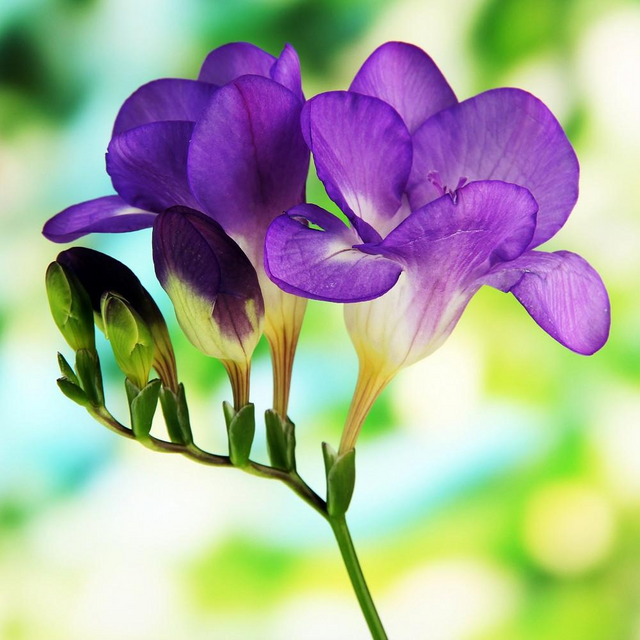
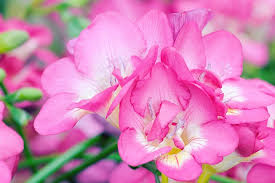
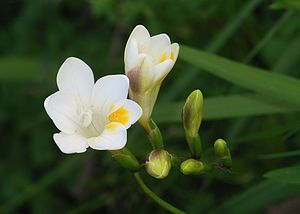
Freesia plants develop from a corm (a strong bulb, as in Gladiolus). The Freesia orm sends up a tuft of long tight leaves and a somewhat expanded stem. Freesia Flowers are borne as free uneven spikes of barely pipe molded blooms along a side couple of clears out. Some great Freesia assortments (antiquated) for scent include: Athene, Allure, Demeter, Excelsior, Golden Wave, Mirabel, Pink Westlind, Snowdon, and Welkin..
The delicate, cormous plant, Freesia started in South Africa. The leaves on Freesia are sword formed and light green and might be up to 1 feet high. Freesia Flower stalks are thin and about a similar stature. Upwards of 8 pipe molded Freesia blooms frame a free group at the highest point of each stalk. Where the blossoms start, the stem makes a sharp twist with the goal that the Freesia blooms confront upward.
Source1 2 34
Downvoting a post can decrease pending rewards and make it less visible. Common reasons:
Submit
Excellent flowers my dear and I love this flowers very much. I love all flowers but it is one of my favorite flower. Thank you very much for sharing with us.
Downvoting a post can decrease pending rewards and make it less visible. Common reasons:
Submit
Very beautiful flowers. I'm glad that thanks to your blog, I can enjoy such beautiful colors. Good luck to you and Love.
Downvoting a post can decrease pending rewards and make it less visible. Common reasons:
Submit
Freesias is one of the most beautiful spring flowers. They are looking beautiful in the garden. This flower is very popular as a cut flower. It has various colours. Thank you so much sir for sharing the beautiful flower.
images source
image source
Downvoting a post can decrease pending rewards and make it less visible. Common reasons:
Submit
Freesia is beautiful flower plant . Long green branches and yellow flowers are just awesome .
Good for every place . Thanks for gardening blog
Downvoting a post can decrease pending rewards and make it less visible. Common reasons:
Submit
And I love these beautiful yellow flowers.
They are very used to decorate the garden and the apartment.
Thank you for the beautiful photo and
interesting spelling, @ctrl-alt-nwo
source
Downvoting a post can decrease pending rewards and make it less visible. Common reasons:
Submit
Freesias is a beautful flower. It has multiple colours but most of them are yellow. It's a Spring flower. Also famous as a cut flowers.
Source link
I love your daily sharing beautiful Australian flowers. Have a great day sir @ctrl-alt-nwo.
Downvoting a post can decrease pending rewards and make it less visible. Common reasons:
Submit
They are herbaceous plants which grow from a conical corm 1–2.5 cm diameter, which sends up a tuft of narrow leaves 10–30 cm long, and a sparsely branched stem 10–40 cm tall bearing a few leaves and a loose one-sided spike of flowers with six tepals. Many species have fragrant narrowly funnel-shaped flowers, although those formerly placed in the genus Anomatheca, such as F. laxa, have flat flowers.
Freesias are used as food plants by the larvae of some Lepidoptera species including Large Yellow Underwing
Downvoting a post can decrease pending rewards and make it less visible. Common reasons:
Submit
you are a big master of brilliant photography and nature beauty big part one of them flower.. Freesias is a one of the best spring bulbs.this amazing flower stayed various kinds of colour and shapes.specially this flower growing every year and position doing fully sun..its fraguant very beautifull.this flower looks very attractive.i am really gots alots of idea of various kinds of flower to seen your daily post and you showing this tropic very properly..i am improved my knowledge to read your flower post..flower always giving freshness and purity moment everyone..its keeps good my mind always and seeing your post i am being excited to recieve doing best idea of flower..i am prode feel doing to got as like friend you and real hero in this platform.your thought quality and supporting to give encourage my own work..i am always appreciating your post..because its alltime my heart touching..very well done.take care yourself and best of luck of your great work.i wish always your bright future.. i want you stayed live long happily in your whole life.keep it up.see you againn.have a great day.. my best wishes anytime with you..my dear good friend.. @ ctrl-alt-nwo
Downvoting a post can decrease pending rewards and make it less visible. Common reasons:
Submit
Downvoting a post can decrease pending rewards and make it less visible. Common reasons:
Submit
The Freesia flower, a herbaceous member of the Iris family, is regarded as one of the most fragrant plants in the world. Freesias are grown for ornamental, as well as practical purposes and can be found in a wide variety of colors, as well as varying fragrances - some stronger than others
Freesia flowers are a beautiful bulb flower that is sure to brighten up your garden! It comes in many beautiful colors and has a very sweet fragrance that is sure to be enjoyable!
Freesias have been crossbred numerous times, and by many different cultures, which resulted in the development of a wide array of variations, all of which boast characteristics all their own.
The Freesia alba and Freesia leichteinii species became wildly popular after making their debut in the late 1800s, and they are still regarded as the most deliciously scented of all Freesia species.
Source
Downvoting a post can decrease pending rewards and make it less visible. Common reasons:
Submit
Speaking of fragrant flowers, Freesias is the most appropriate answer!
White Freesias is considered to be the most fragrant, but the flowers can be found in variations of yellow, orange, red, purple, light purple and pink, and striped varieties of each color.
Freesias are suitable for planting on the ground or in pots. Freesias can flower about 12 weeks after planting. After blooming, Freesias will continue to bloom for months.
Source:
https://www.google.co.id/url?sa=t&source=web&rct=j&url=https://en.m.wikipedia.org/wiki/Freesia&ved=2ahUKEwjRjb-LoaTdAhXQdysKHfYsCkYQFjAAegQIAxAB&usg=AOvVaw15ypDdEthATcQsQdi5mpyF
Downvoting a post can decrease pending rewards and make it less visible. Common reasons:
Submit
When to Plant Freesia Bulbs In USDA hardiness zones 9 and warmer, you can plant freesia corms in fall. In cooler areas, however, plant the corms in spring. Also, in USDA zones cooler than 9, the corms won’t survive the winter in the garden. You will need to dig them up at the end of the season and store them until next spring, but since the corms are inexpensive, it’s usually easier to purchase a new freesia bulb plant next year. Another option is to plant them in containers so you can bring the entire pot indoors for winter storage.

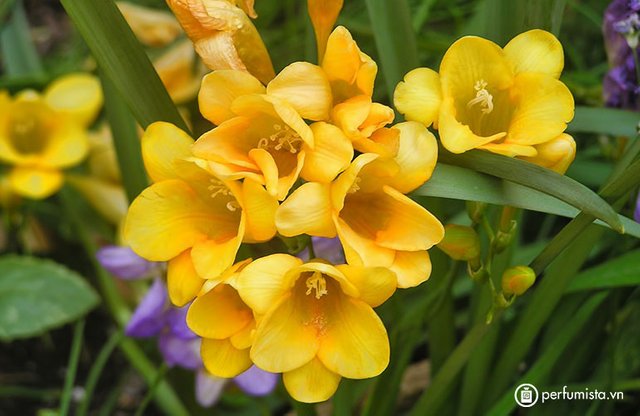

How to Grow Freesias Indoors Freesias bloom readily indoors. Plant the bulbs about 2 inches apart in a pot filled with regular potting soil. Keep the soil moist, but not soggy, and place the pot in a sunny, preferably south-facing window. Expect flowers in 10 to 12 weeks. Once the flowers and foliage die back, allow the pot to dry out and place it in a cool location until you are ready to bring them into bloom again.
Freesia Flower Care Once the foliage emerges, water the growing freesia plants often to keep the soil moist. Freesias need an abundance of moisture during the entire growing season, but you should allow the soil to dry out once the flowers fade. Fertilize the plants in spring with a bulb fertilizer following the label instructions. You can also pick off faded flowers to keep the garden looking tidy, but allow the foliage to die back naturally.
Freesias make excellent cut flowers too. Cut the stems early in the morning before warm temperatures have a chance to dry out the blossoms. Cut the stems again at a slight angle an inch or so above the first cut while holding them under water. Place them in a vase of water right away. You can add a floral preservative if you like, but you won’t need it if you change the water daily. Site
Downvoting a post can decrease pending rewards and make it less visible. Common reasons:
Submit
Downvoting a post can decrease pending rewards and make it less visible. Common reasons:
Submit
Freesia stems are thin and can not always support the weight of the head of the flower, especially on varieties that produce double blooms. A growing battle system that has a grid to support flowers and leaves will keep the plant upright.
Freesia plants will appear to decrease after the blooming cycle and active growth. The plant may enter dormancy, not dying, so don't throw it away. Cut back the yellowing leaves, and store the container in a dry place. You can move the container outdoors in the spring, keeping the cup inactive in a dry and warm place until the growth begins again.
Sources :
https://www.google.co.id/url?sa=t&source=web&rct=j&url=https://id.nctodo.com/freesia-flowers&ved=2ahUKEwiimJmKuandAhXLL48KHeQsAo4QFjAQegQIABAB&usg=AOvVaw0vCLTv8oVsAfwjn08_K0ov
Downvoting a post can decrease pending rewards and make it less visible. Common reasons:
Submit
@ctrl-alt-nwo
This is wonderful garden and so really look yellow flowers. that is useful information. fantastic photography.
Downvoting a post can decrease pending rewards and make it less visible. Common reasons:
Submit
Downvoting a post can decrease pending rewards and make it less visible. Common reasons:
Submit
Downvoting a post can decrease pending rewards and make it less visible. Common reasons:
Submit
Freesia is a genus of herbaceous perennial flowering plants in the family Iridaceae, first described as a genus in 1866 by Chr. Fr. Echlon (1886) and named after German botanist and doctor Friedrich Freese (1794-1878). It is native to the eastern side of southern Africa, from Kenya south to South Africa, most species being found in Cape Provinces.Species of the former genus Anomatheca are now included in Freesia. The plants commonly known as "freesias", with fragrant funnel-shaped flowers, are cultivated hybrids of a number of Freesia species. Some other species are also grown as ornamental plants
Downvoting a post can decrease pending rewards and make it less visible. Common reasons:
Submit
Freesias are gorgeous and delicate exotics from the other side of the world – they grow wild in the Cape Province of South Africa – so we tend to think that growing them here will be difficult, but this simply isn't true.
If you want to grow your own look for prepared corms rather than so-called 'garden varieties'. Prepared means that the freesia bulbs (corms) have been subjected to a dormancy-breaking heat treatment – an average of 12 weeks at 30C. The idea behind this is to mimic the conditions in South Africa. There they dry out and become dormant in the hot summer, only beginning to grow in the warm, moist autumn. They then have a cool patch in winter, which initiates flower-bud formation. These are the types of corms we sell at Sarah Raven.
PLANTING
Soil and Site
Well-drained spot, in sun or light shade. Add plenty of organic matter to improve thin soils.
Spacing
Plant them 5cm deep and 5-8 cm apart. The bulbs look like small, slim onions. Plant them with the pointed end facing up.
In the garden
Our prepared freesia corms can be planted in autumn for flowering inside from January to April or from March (in a greenhouse) or April-July (outside). I have gone on planting outside until July for flowers almost up until Christmas. Plant the corms straight into the ground in a well-drained spot in sun or light shade. I grew some very successfully last summer and autumn in a west-facing bed against a hedge.
When the plants are up and growing, they will benefit from a potash-rich feed – comfrey juice or something you would use for tomatoes (see our website for details).
For containers
Plant six bulbs, pointy end upwards (again at 1-2 in deep) in a 13cm/5in pot, or spaced at that equivalent in a larger pot. They like a rich, loam-based compost (which I expect explains why they do well on my heavy soil) with a little extra grit added for drainage. Go for about two thirds compost, one third grit.
Water regularly and keep them moist and shaded at all times – a cold greenhouse or conservatory is ideal. Once the corms start to sprout, move the pots into full sunlight and keep watering. When the buds show colour, you can bring them indoors. If they have been planted in good soil or compost they will not require feeding.
https://encrypted-tbn0.gstatic.com/images?q=tbn:ANd9GcR68zffOxOlWiulW1dFQ53f7d58Go0VqZOhp-CezrBAHr24kvNEHA
Downvoting a post can decrease pending rewards and make it less visible. Common reasons:
Submit
A member of the Iridaceae family, Freesia is one of the most common plants used in making bouquets to give out as gifts. Known for their light, alluring fragrance, much like roses, they’re associated with Valentine’s Day.
Description
Freesias have funnel-shaped flowers which come in shades of red, yellow, white or even mauve. Their gentle pastel colours are one of the main reasons why they’re a mainstay of flower shops the world over.
Habitat
Most species of Freesia are native to Africa, specifically the Cape Province region of South Africa. However, two species originate from north of the equator and reach as far as Sudan.
Availability
Freesia plants are usually available during the spring and summer months, although if grown correctly, they can last well into the autumn months.
Species
There are 14 known species of Freesia, all of which are usually found in Africa, although they can now be seen in more northerly climates, including the British Isles.
Downvoting a post can decrease pending rewards and make it less visible. Common reasons:
Submit
Their bright colours and heavy perfume make freesia a popular cut flower. Freesias are native to South Africa where they are winter growing plants and are frost tender. The modern hybrid freesias, Freesia × kewensis, are derived from crosses between Freesia refracta and Freesia armstrongii. Prepared corms planted outside in April will flower in late summer or they can be grown in a cool greenhouse for spring flowering.
Facts
Common name Freesia
Botanical name Freesia
Group Deciduous cormous perennial
Flowering time July August
Planting time April for prepared corms
Height and spread 40cm (16in)
Aspect Sunny/well-lit
Hardiness Tender minimum of 5°C (41°F)
Difficulty Moderate
Downvoting a post can decrease pending rewards and make it less visible. Common reasons:
Submit
Very nice plants @ctrl-alt-nwo sir
I like it your every Post. I appreciate your valuable photography. thanks for sharing this beautiful garden..
Downvoting a post can decrease pending rewards and make it less visible. Common reasons:
Submit
You have a very good job posting such a beautiful beautiful picture which is very good to see in my beautiful pictures of such beautiful flowers.
Downvoting a post can decrease pending rewards and make it less visible. Common reasons:
Submit
Downvoting a post can decrease pending rewards and make it less visible. Common reasons:
Submit
Downvoting a post can decrease pending rewards and make it less visible. Common reasons:
Submit
very beautiful flower. bright yellow is a very beautiful flower color. Flowers that bloom give meaning to peace.regards @ctrl-alt-nwo
Downvoting a post can decrease pending rewards and make it less visible. Common reasons:
Submit
Beautiful garden photography sir.
I like it this beautiful garden. I appreciate your valuable content. thank you so much sir for sharing this Australia...
Downvoting a post can decrease pending rewards and make it less visible. Common reasons:
Submit
Freesias are tender, brightly flowered, easy to care for bulbs that can be grown in the garden,
in planters, or as a house plant in a sunny, cool room.
Their fragrant, 2" flowers open over a long blooming period, in sequence along 12"-18", arching, wirey stems.
They have narrow, sword shaped basal foliage and a few small leaves on each flower stem.
Downvoting a post can decrease pending rewards and make it less visible. Common reasons:
Submit
The natural flowering season of Freesias in Israel is from mid-March to mid-April. At this season, the supply of flowers of local production in Europe is at its peak and prices are low.
Due to the relatively high light intensities and the moderate temperatures prevailing in most parts of Israel during the winter, we are able to grow Freesias throughout the winter in unheated plastic houses or under other types of light protection, such as saran-shade houses. A treatment that will advance the blooming date by one to three months will be of great value to growers, since it will extend the flowering season and shift part of the production to a season of better prices and higher demand.
The physiological requirements for flower formation and the regulation of flowering have been studied in recent years both in corms (3,4) and in seed-raised Freesias (5). It was found, that although photoperiod has some effect on flowering (6), temperature rather than day-length is the decisive factor which governs over growth and flowering in Freesia plants. The optimal range of temperature required for induction and formation of flowers is 12–15°C. Inductive temperature should be applied at the correct stage of development. The preparation of plants for cold treatment depends on the way they are raised, namely from corms or from seeds. It was found (5) that in order to obtain high-quality flower production in seed-grown plants, cold treatment should start when plants are at the stage of 6–8 leaves.
In corm-raised plants dormancy of corms should be broken before the application of cold treatment. The breaking of dormancy in Freesia, unlike in many tuberous plants like Gladiolus, is performed not at low temperatures but around 30°C. Flower formation in corm-raised Freesias, like in Gladiolus, starts soon after sprouting. Cold temperature is essential not only for flower induction, but also for its formation.
Hartsema (3,4) suggested the following treatment as a means for obtaining early flowering. It is based on her experiments with Freesia corms and comprises of storage for 10 weeks at 31°C and for 4 weeks at 13°C followed by planting in a cool greenhouse. However, Hartsema (4) states that "Practical growers did not succeed in using our method for production of early flowering, probably because the temperature in the greenhouse cannot be kept optimal at 13–15°C during September without refrigeration".
Downvoting a post can decrease pending rewards and make it less visible. Common reasons:
Submit
Freesia is a genus of about 15 species of perennial, bulbous plants grown for their showy, fragrant flowers. All are endemic to southern Africa. Freesias are popular commercial cutflowes, garden and houseplant favorites and many are grown for their fragrant oils that are extracted from the flowers and used for scenting perfumes, lotions and candles.
The plants have green, narrow leaves that are linear or sword-shaped and clustered. Only a few leaves arise from the bulbous corms (bulbous, compressed, solid, underground stems covered with a fibrous skin). The flowers appear among the foliage on long spikes. Each spike may be branched or unbranched and bears flowers on one side. The flowers have petals/tepals that form tubular or funnel-shaped blooms that begin to open from the base of the spike up. Flowers are usually white or yellow and sometimes pink or red. The fruit is a round, warty capsule. There are many cultivars and varieties with a wide range of flowers colors.
Culture and hardiness is species dependent, however, most Freesia prefer slightly acid, organic-rich soil with ample drainage. They prefer sunny to partly sunny locations and look best when grown in masses. These plants do not tolerate very cold or hot conditions. Plant them in the spring in temperate zones and the fall in sub-tropical and tropical areas. Cut or remove the flower stalk and leave the remaining foliage to replenish the corm for next season’s blooms. The corms should be lifted and stored in areas where with freezing winters. They may also be lifted and stored in the summer in areas with where temperatures are hot and really moist.
Freesia is an excellent plant for forcing or greenhouse culture where not hardy. They are beautiful in beds, containers and cutting gardens. If corms are planted at intervals, successions of blooms will grace the garden for cutting. Expect flowers to appear about 10 to 12 weeks after planting.
Downvoting a post can decrease pending rewards and make it less visible. Common reasons:
Submit
Thanks for the information of freesias flowers garden. its very useful detail.
You are a with a lot of knowledge about the garden. the great work and experience
thanks for sharing.
@ctrl-alt-nwo
Have a nice day.
Downvoting a post can decrease pending rewards and make it less visible. Common reasons:
Submit
Beautiful garden photography @ctrl-alt-nwo sir
I like it this beautiful plants. I appreciate your valuable photography. thanks for sharing this beautiful Australia..
Downvoting a post can decrease pending rewards and make it less visible. Common reasons:
Submit
Beautiful garden photography.
I like it this beautiful plants. I appreciate your valuable content. thanks for sharing this.
Downvoting a post can decrease pending rewards and make it less visible. Common reasons:
Submit
Hello my best friend @ctrl-alt-nwo how are you good hope i love you every day post you are a citizen of Australia i love a lot of australia country and i love the gardens of Australia more love you post so beautiful flowers pictures that i have never seen in life so beautiful Beautiful flowers are actually very beautiful beautiful flowers you can post.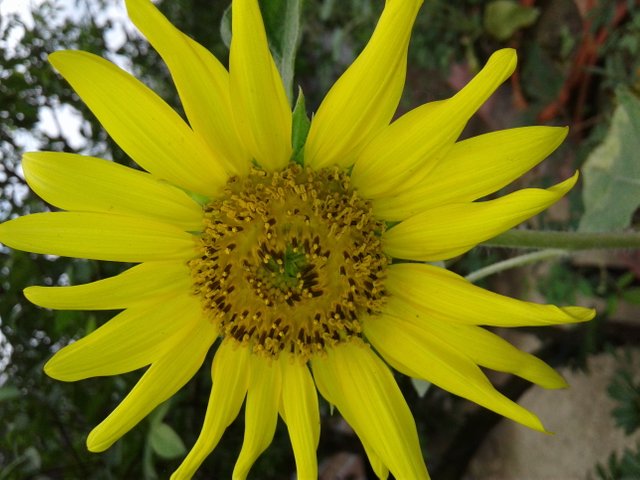
I love the country of Australia and I respect the people of Australia, I respect you so much and I love your post..
Downvoting a post can decrease pending rewards and make it less visible. Common reasons:
Submit
Beautiful garden photography @ctrl-alt-nwo sir
I like it your every photography. I appreciate your valuable Post. thank you so much sir for sharing this beautiful plants..
Downvoting a post can decrease pending rewards and make it less visible. Common reasons:
Submit
@ctrl-alt-nwo
Wow!That is a Wonderful flowers & its really looks for Spring Bulbs flowers. so great information.
100% like and resteem
Downvoting a post can decrease pending rewards and make it less visible. Common reasons:
Submit
Freesia is a genus of about 14 species. Freesia bulbs are usually grown for use asCut Flowers. All the 14 species of Freesia are African in origin. Of The 14 Freesia species, 12 are native to Cape Province, South Africa, the remaining two to tropical Africa, with one these species extending north of the equator to Sudan. Freesia flowers are very fragrant, typically white or yellow, and are borne in spikelike racemes. This blooming beauty captures your heart and is a springtime favorite.
Downvoting a post can decrease pending rewards and make it less visible. Common reasons:
Submit
Freesia flowers are “zygomorphic” which just means that they grow along one side of the stem, in a single plane. When you look at a flower stalk however, you'll see that the blooms are facing upwards. How does this work? Freesias stems have the unusual habit of turning at right angles just below the bottom flower. This causes the upper portion of the stem to grow almost parallel with the ground. The flowers bloom along the top side of the stalk, facing upwards. This makes them lovely to look down into in a garden setting and ideal for arrangements. If you didn't care much for geometry in high school, here's a painless way to give it another try.
Downvoting a post can decrease pending rewards and make it less visible. Common reasons:
Submit
Quote the Source for your photos if they are not your own.
Downvoting a post can decrease pending rewards and make it less visible. Common reasons:
Submit
Great job! ;)
Downvoting a post can decrease pending rewards and make it less visible. Common reasons:
Submit
They look very lovely.
Growing them along with some red or pink flowers will definitely bring out more of its beauty.
Nature is indeed blessed
Downvoting a post can decrease pending rewards and make it less visible. Common reasons:
Submit
@ctrl-alt-nwo

That is Wonderful article.
I feel that you also feel special about the estates the perfect work.
thanks for sharing.
Downvoting a post can decrease pending rewards and make it less visible. Common reasons:
Submit
These plants are awesome as they are best for me thanks for your special blog post sir.
Downvoting a post can decrease pending rewards and make it less visible. Common reasons:
Submit
The spring is coming🤗
Downvoting a post can decrease pending rewards and make it less visible. Common reasons:
Submit
A wide range of colors and an alluring floral fragrance make freesia hard to resist. With up to eight trumpet-shaped, upward-pointing blossoms on leafless stems, freesias make delightful cut flowers that last a long time in the vase. The freesia bulb plant is easy to force indoors on sunny windowsills. Learning how to grow freesias in the garden and freesia flower care will allow you to enjoy these beauties year after year. How to Plant a Freesia Corm in the Garden Knowing how and when to plant freesia bulbs is important for their success in the garden. Start by choosing a location with full sun or light morning shade and well-drained soil. Prepare the bed by digging and loosening the soil to a depth of at least 8 inches. Plant the freesia bulbs, or corms, at least 2 inches deep and 2 to 4 inches apart. Freesias look their best planted in groups or masses rather than in rows. Masses of a single color make a striking display. Freesias bloom 10 to 12 weeks after you plant the corms. You can extend the bloom season by planting the bulbs at weekly intervals. When to Plant Freesia Bulbs In USDA hardiness zones 9 and warmer, you can plant freesia corms in fall. In cooler areas, however, plant the corms in spring. Also, in USDA zones cooler than 9, the corms won’t survive the winter in the garden. You will need to dig them up at the end of the season and store them until next spring, but since the corms are inexpensive, it’s usually easier to purchase a new freesia bulb plant next year. Another option is to plant them in containers so you can bring the entire pot indoors for winter storage. How to Grow Freesias Indoors Freesias bloom readily indoors. Plant the bulbs about 2 inches apart in a pot filled with regular potting soil. Keep the soil moist, but not soggy, and place the pot in a sunny, preferably south-facing window. Expect flowers in 10 to 12 weeks. Once the flowers and foliage die back, allow the pot to dry out and place it in a cool location until you are ready to bring them into bloom again. Freesia Flower Care Once the foliage emerges, water the growing freesia plants often to keep the soil moist. Freesias need an abundance of moisture during the entire growing season, but you should allow the soil to dry out once the flowers fade. Fertilize the plants in spring with a bulb fertilizer following the label instructions. You can also pick off faded flowers to keep the garden looking tidy, but allow the foliage to die back naturally. Freesias make excellent cut flowers too. Cut the stems early in the morning before warm temperatures have a chance to dry out the blossoms. Cut the stems again at a slight angle an inch or so above the first cut while holding them under water. Place them in a vase of water right away. You can add a floral preservative if you like, but you won’t need it if you change the water daily.
Downvoting a post can decrease pending rewards and make it less visible. Common reasons:
Submit
This is very beautiful plant , it's yellow color flowers are awesome and eye catching. Presence of this plant in garden, will growing the beauty of garden.
Downvoting a post can decrease pending rewards and make it less visible. Common reasons:
Submit
Native to Africa, Freesia is a genus of 14-16 species of flowering plants in the Iris family. Freesias are strongly scented so they make a nice addition to any area. They have five to 10 single or double flowers. Stems are usually 10 to 18 inches long with little or no foliage. The bell-shaped freesia blooms up to seven days and comes in white, golden yellow, orange, red, pink, mauve, lavender, purple and bicolors. They are herbaceous plants which grow from a corm 1-2.5 cm diameter, which sends up a tuft of narrow leaves 10-30 cm long, and a sparsely branched stem 10-40 cm tall bearing a few leaves and a loose one-sided spike of fragrant narrowly funnel-shaped flowers.
Downvoting a post can decrease pending rewards and make it less visible. Common reasons:
Submit
So very beautiful garden, thanks for sharing.really nice for Freesias flowers.....
Resteem
Downvoting a post can decrease pending rewards and make it less visible. Common reasons:
Submit
Why no Source quoted? Are they your own photos?
Downvoting a post can decrease pending rewards and make it less visible. Common reasons:
Submit
With its beautiful flower condition and its fragrant aroma it is certainly suitable to be planted in pots and placed in the yard.
Thanks to share @crtl-alt-nwo
Downvoting a post can decrease pending rewards and make it less visible. Common reasons:
Submit
Fragrant flowers in a stunning colour range. These blooms are a spring must have, the flowers are profuse, easy to grow and will flower for weeks on end. Freesias are great bulbs for naturalising as they are well suited to Australian conditions. They grow best in full sun to light shade in any well drained soil and don’t need much in the way of care. The blooms last well in a vase and we recommend picking them as the first flower opens.
Freesias are generally available from Mid January until Mid May.
Downvoting a post can decrease pending rewards and make it less visible. Common reasons:
Submit
Freesias were my best gardening success last year. They can be a washout if you start with corms that have been sitting around too long in their bag, so that all life’s juices have been drawn out of them. I had tried growing “garden varieties” a couple of times with hopeless results. The odd leaf emerged and not a single flower.
Then – last spring – I visited a freesia grower in Holland who explained that to flower reliably, the corms must be professionally heat-prepared and then stored carefully until planting. They need to be subjected to the dormancy-breaking heat treatment – an average of 12 weeks at 30C (86F) after lifting – and then kept at not much below this until the frosts are over and they make it into the ground. This – he said, with the so-called “prepared corms” – mimics what they would find in their native Cape in South Africa and ensures good growing and flowering.
So last year, I came back from Holland with several bags and waited for the frosts to be almost certainly over. I then started planting a batch of about 20 corms every two to three weeks from late April until July. Most went into an east-facing border against a hawthorn hedge, a partially shaded spot in the cutting garden, although I also planted some up in a few pots for scattering around the greenhouse.
I had almost given up and thought that, yet again, all I would get were their veiny, flattened, crocosmia-like leaves. But four months later (that’s what they take – about 100 to 120 days from planting), the first freesia flowers began to appear. And then you couldn’t stop them. They flowered their socks off, with the latest batch continuing to produce new spikes after the first hard frost. The flowers were then marked by the cold, but kept on coming until I lifted most and dried them off inside.
The pots in the greenhouse fared slightly less well. Based on having seen them growing in the wild, I had imagined they liked intense heat once growing, but the light shade of the garden hedge seemed to suit them well, and I now know that if grown in a greenhouse, they are happiest with a bit of shading, particularly in the early stages.
Downvoting a post can decrease pending rewards and make it less visible. Common reasons:
Submit
HOW TO GROW FREESIAS…
Freesia bulbs can be planted into the ground or in pots from April to July and should flower in summer and autumn.
Pots should be around 13cm in depth.
Plant around 7 bulbs per pot (select bulbs that are large and firm for the best results), pointed end upwards, 1-2 inch deep, covering firmly.
Use a rich or multipurpose compost with added 1/3 grit for good drainage.
Water regularly to keep damp (but not wet) and keep shaded in a cold greenhouse or conservatory to establish a firm rooting system.
Once growth has started, place in a sunny window or put into full sunlight outside and keep watering.
The plants will grow for approximately 12 weeks before blooming. When the buds show colour, you can bring them indoors.
Freesias need support to keep upright as they grow - wooden garden canes can be used. Stake freesias when they reach a height of 6 to 8
Downvoting a post can decrease pending rewards and make it less visible. Common reasons:
Submit
Freesias make great container plants that should be planted in the spring for garden use, or planted in the fall for growing indoors.When growing Freesias in pots or planters, drainage is critical!Make certain the container has sufficient drainage holes to prevent waterlogged soil, or the corms will quickly rot.Fill the container with any good, commercial potting soil and plant the bulbs 2" deep and 2".It is a good idea to add a support stake at planting time, to avoid root damage later.Keep the soil shaded and barely moist until new shoots appear, then water enough to keep the soil evenly moist, but never soggy.Feed container grown Freesias weekly when actively growing, with a good soluble fertilizer, mixed at half the recommended strength.
Downvoting a post can decrease pending rewards and make it less visible. Common reasons:
Submit